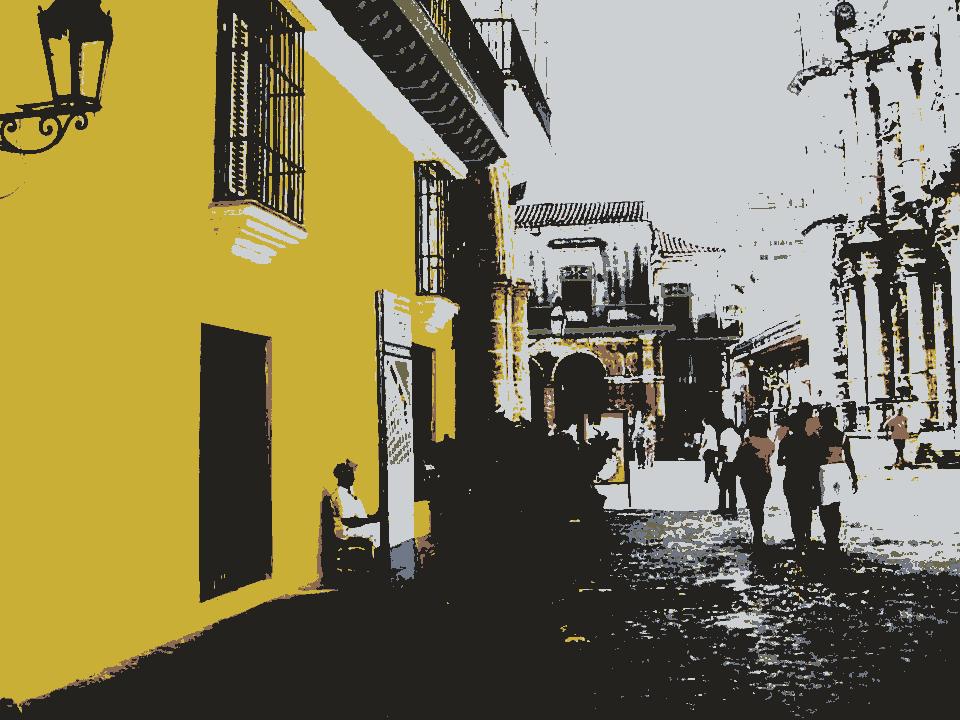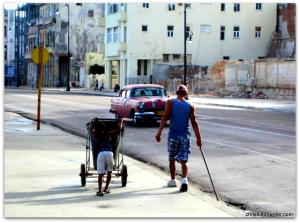The buildings here are much the same as they were when the revolution occurred. They have been extended upwards and backwards, but the main structures are the same as they were then. Many are in disrepair. Three, four or five stories have been added to most of the buildings. Most have gas and electric systems that would be illegal in most other countries: wires and tubes protruding everywhere. Even on Obispo, the most touristy of streets, there is nothing new. Away from Old and Central Havana there are fairly new flats, but it is hard to find any progress.
The building opposite us is empty. Some of its balconies are shored up. It must have been some kind of government building, whatever, definitely not inhabited. Perhaps one hundred years old, on a list somewhere for renovation. I have only seen what there is between Jose Marti Airport and central and old Havana. But I have not noticed any change; there are many derelict factories, many more signs of dilapidation than progress. Occasionally there is a newish building with a newish business, but it all seems a bit depressing. Perhaps progress is being made, but in a depressed world economy and a collapsing Cuban economy, it is hard to find it. Apart from tourism, I’m not sure that the Cubans have much going for them.
I don’t really know anything beyond Old, Central, Bahia Honda, Villa Pan Americana or Guanabacoa, I don’t know much about Cuba. I lived in Villa Pan Americana for a year; I lived in Guanabacoa for six months; I stayed in Bahia Honda on several occasions, Lugareno too; I stayed in various places in Havana many, many times. I noticed much about those places, felt at home in them, was part of them. But I still feel that I don’t know much about Cuba. I know a lot more than most foreigners, but still not much.
I’ve seen how the very poorest live and the rich too. Some clearly stayed rich after the revolution – I don’t know how. Some get money sent to them from the United States, many don’t. This trip I had been unsure until the last minute whether I wanted to come or not; I have been bored by my last few visits. But then I had a different outlook; I was mainly clubbing and drinking and getting up at midday. Now, I have adjusted to the pace of life here; I’m looking at it from a different point of view. I like it. It needs money. Not a great deal, but more than I have, so far.
According to Graham Greene,
‘The Spanish, the French and the Portuguese built cities where they settled, but the English just allowed cities to grow.’
I hadn’t thought about that before, but it is true. This is a Spanish city that has had a Cuban makeover, but very little has been added; most of what has been added is for the benefit of tourists, not Cubans. I think plans are afoot to improve the Cubans lot, but they will be slow and very gradual. Much will depend on the success of quasi-socialist governments in South America. Can they hold out against US influence or will they find a way to succeed? If they do succeed, even partially, then Cuba will have friends and allies. If the embargo were to end (without the US taking over), that would help tremendously too.
I don’t think Cuba will change quite as quickly as some people suppose. There are plans in place for gradual change, but what influence will the new entrepreneurship have on the people? Will the taste of money change everything? Or will they continue with a vaguely socialist outlook? Whatever happens, I hope that change doesn’t come too quickly, that Cubans somehow find a way to retain their uniqueness. It really is unique here; it would be awful if Cuba were just to become like everywhere else.




